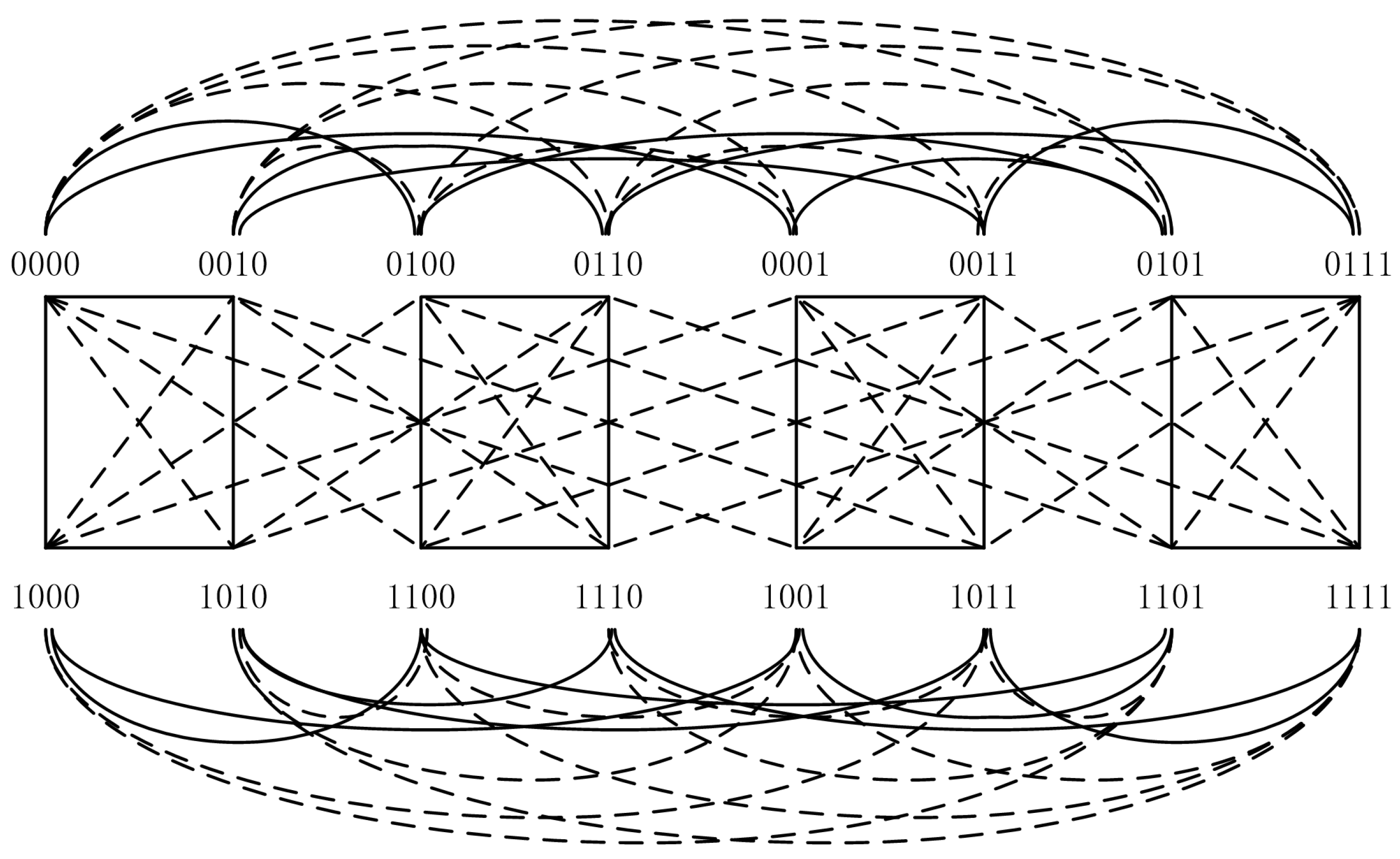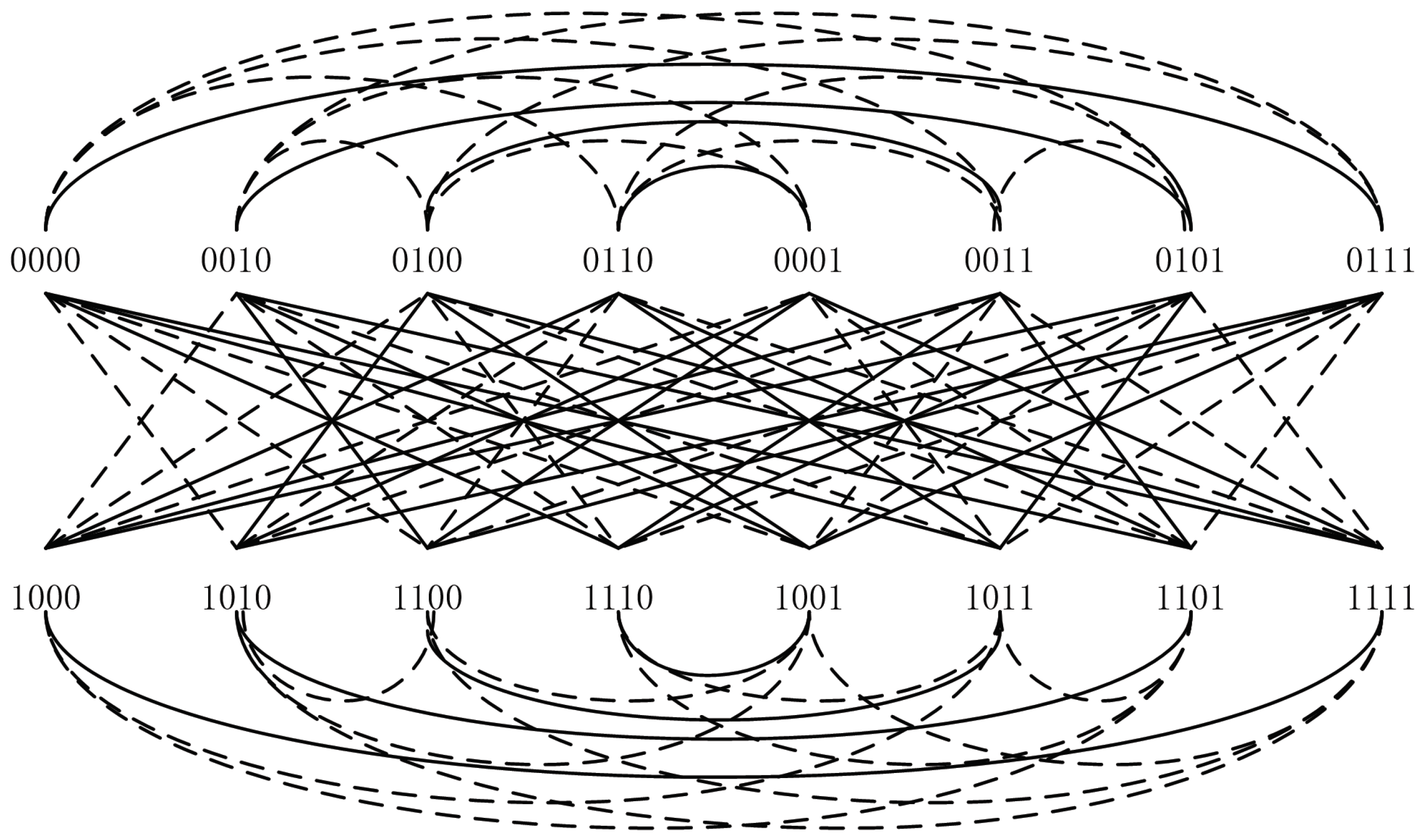The Square of Some Generalized Hamming Graphs
Abstract
:1. Introduction
2. Preliminaries
3. Squares of Generalized Hamming Graphs and NEPS of Complete Graphs
3.1. The Square of with Each
3.2. The Square of
- (a)
- If for , then:where ;
- (b)
- If for , then:where .
- (a)
- If , then:where .
- (b)
- If , then:where .In particular, if , then:
3.3. The Square of with Each
- (a)
- Suppose that and . Then:where .
- (b)
- Suppose that , , and there exist a and b with (possibly with ) such that . Then:
- (a)
- If and , let . Then:
- (b)
- If and , let . Then:
- (c)
- If and , let . Then:
- (d)
- If and , let . Then:
- (e)
- If and , let . Then:
- (1)
- Consider the square of the generalized Hamming graph . Obviously, , and by Theorem 6 (a), we have:where .
- (2)
- Consider the square of the generalized Hamming graph . Obviously, , and by Theorem 6 (b), we have:where .
- (3)
- Consider the square of the generalized Hamming graph . Obviously, , and by Theorem 6 (c), we have:where .
- (4)
- Consider the square of the generalized Hamming graph . Obviously, , and by Theorem 6 (d), we have:where .
- (5)
- Consider the square of the generalized Hamming graph . Obviously, , and by Theorem 6 (e), we have:where .
4. Eigenvalues of the Square of Generalized Hamming Graphs
- (a)
- For , is a complete graph.
- (b)
- For , let and . Assume the elements in L are .
- (b.1)
- If , then the eigenvalues of are:
- (b.2)
- If , then the eigenvalues of are:
where if and if .
- (a)
- If , then is a complete graph.
- (b)
- If , let and . Assume the elements in L are .
- (b.1)
- If , then the eigenvalues of consist of all possible values:
- (b.2)
- If , then the eigenvalues of consist of all possible values:
- (a)
- If , then is a complete graph.
- (b)
- If , let and . Assume that the elements in L are . Then, the eigenvalues of are:where if and if .
- (1)
- Consider the generalized Hamming graph . Obviously, Theorem 3 implies that:By Theorem 8, its eigenvalues are , and with respective multiplicities 12 and 4.
- (2)
- Consider the generalized Hamming graph . Obviously, Theorem 4 implies that:By Theorem 9, its eigenvalues are with respective multiplicities .
- (3)
- Consider the generalized Hamming graph . Obviously, Theorem 6 implies that:By Theorem 10, its eigenvalues are , and with respective multiplicities and 4.
5. Conclusions
Author Contributions
Funding
Data Availability Statement
Conflicts of Interest
Appendix A
References
- Balinska, K.; Cvetkocić, D.; Rodosavljević, Z.; Simić, S.; Stevanović, D. A survey on integral graphs. Publ. Elektroteh. Fak. Ser. Mat. 2003, 13, 42–65. [Google Scholar]
- Wang, L. A Survey of Results on Integral Trees and Integral Graphs; Memorandum 1763; Department of Applied Mathematics, University of Twente: Enschede, The Netherlands, 2005. [Google Scholar]
- Hahn, G.; Sabidussi, G. (Eds.) Graph Symmetry: Algebraic Methods and Applications; NATO Science Series C; Springer: Dordrecht, The Netherlands, 1997. [Google Scholar]
- Khaefi, Y.; Akhlaghi, I.; Khosravi, B. On the subgroup perfects codes in Cayley graphs. Des. Code Cryptogr. 2023, 91, 55–61. [Google Scholar] [CrossRef]
- Liu, Y.; Yuan, J.; Dai, W.; Li, D. Three-state quantum walk on the Cayley Graph of the Dihedral Group. Quantum Inf. Process. 2019, 20, 106. [Google Scholar] [CrossRef]
- Bašić, M.; Petković, M.D.; Stevanović, D. Perfect state transfer in integral circulant graphs. Appl. Math. Lett. 2009, 22, 1117–1121. [Google Scholar] [CrossRef]
- Li, Y.; Liu, X.; Zhang, S.; Zhou, S. Perfect state transfer in NEPS of complete graphs. Discret. Appl. Math. 2021, 289, 98–114. [Google Scholar] [CrossRef]
- Sander, T. Eigenspaces of Hamming graphs and unitary Cayley graphs. Ars Math. Contemp. 2010, 3, 13–19. [Google Scholar] [CrossRef]
- Klotz, W.; Sander, T. Integral Cayley graphs over abelian groups. Electron. J. Combin. 2010, 17, 81–94. [Google Scholar] [CrossRef]
- Cvetkocić, D.; Petrić, M. Connectedness of the non-complete extended p-sum of graphs. Zb. Rad. Prir. Mat. Fak. Univ. Novom Sadu Ser. Mat. 1983, 13, 345–352. [Google Scholar]
- Cvetkocić, D.; Rowlingson, P.; Simić, S. Eigenspaces of Graphs; Encyclopedia of Mathematics and its Applications; Cambidge University Press: London, UK, 1997. [Google Scholar]
- Cvetkocić, D.; Rowlingson, P.; Simić, S. An Introduction to the Theory of Graph Spectra; Cambridge University Press: London, UK, 2010. [Google Scholar]
- Imrich, W.; Klavžar, S. Product Graphs: Structure and Recognition; Wiley-Interscience Series in Discrete Mathematics and Optimization; Wiley: New York, NY, USA, 2000. [Google Scholar]
- Petrić, M. Connectedness of the generalized direct product of diagraphs. Univ. Beograd. Publ. Elektroteh. Fak. Mat. 1995, 6, 30–38. [Google Scholar]
- Zheng, S.; Liu, X.; Zhang, S. Perfect state transfer in NEPS of some graphs. Linear Multilinear Algebra 2020, 68, 1518–1533. [Google Scholar] [CrossRef]
- Klotz, W.; Sander, T. GCD-graphs and NEPS of complete graphs. Ars Math. Contemp. 2013, 6, 289–299. [Google Scholar] [CrossRef]
- Linial, N. Locality in distributed graph algorithms. SIAM J. Comput. 1992, 21, 193–201. [Google Scholar] [CrossRef]
- Das, K.C.; Guo, J.M. Laplacian eigenvalues of the second power of a graph. Discret. Math. 2013, 312, 626–634. [Google Scholar] [CrossRef]
- Das, K.C.; Guo, J.M. Eigenvalues of the k-th power of a graph. Math. Nachr. 2016, 289, 1585–1593. [Google Scholar] [CrossRef]
- Klotz, W.; Sander, T. Distance powers and distance matrices of integral Cayley graphs over abelian groups. arXiv 2012, arXiv:1206.4398. [Google Scholar] [CrossRef]
- Liu, X.; Li, B. Distance powers of unitary Cayley graphs. Appl. Math. Comput. 2016, 289, 272–280. [Google Scholar] [CrossRef]
- Naser, T. Diameter of Ramaujan graphs and Random Cayley graph. Combinatorica 2019, 39, 427–446. [Google Scholar]
- An, X.; Wu, B. The Wiener index of the k-th power of a graph. Appl. Math. Lett. 2008, 21, 436–440. [Google Scholar] [CrossRef]
- Chebikin, D. Graph powers and k-ordered Hamiltonicity. Discret. Math. 2008, 308, 3220–3229. [Google Scholar] [CrossRef]
- Omar, A.A.; Hasan, A.; Mathmound, A. The Wiener polynomial of the kth power graph. Int. J. Math. Math. Sci. 2007, 2007, 24873. [Google Scholar]
- Su, G.; Xiong, L.; Gutman, I. Harary index of the k-th power of a graph. Appl. Anal. Discret. Math. 2013, 7, 94–105. [Google Scholar] [CrossRef]
- Zhang, W.; Wu, B.; An, X. The hyper-Wiener index of the kth power of a graph. Discret. Math. Algorithms Appl. 2011, 3, 17–23. [Google Scholar] [CrossRef]


Disclaimer/Publisher’s Note: The statements, opinions and data contained in all publications are solely those of the individual author(s) and contributor(s) and not of MDPI and/or the editor(s). MDPI and/or the editor(s) disclaim responsibility for any injury to people or property resulting from any ideas, methods, instructions or products referred to in the content. |
© 2023 by the authors. Licensee MDPI, Basel, Switzerland. This article is an open access article distributed under the terms and conditions of the Creative Commons Attribution (CC BY) license (https://creativecommons.org/licenses/by/4.0/).
Share and Cite
Li, Y.; Zhang, J.; Wang, M. The Square of Some Generalized Hamming Graphs. Mathematics 2023, 11, 2487. https://doi.org/10.3390/math11112487
Li Y, Zhang J, Wang M. The Square of Some Generalized Hamming Graphs. Mathematics. 2023; 11(11):2487. https://doi.org/10.3390/math11112487
Chicago/Turabian StyleLi, Yipeng, Jing Zhang, and Meili Wang. 2023. "The Square of Some Generalized Hamming Graphs" Mathematics 11, no. 11: 2487. https://doi.org/10.3390/math11112487
APA StyleLi, Y., Zhang, J., & Wang, M. (2023). The Square of Some Generalized Hamming Graphs. Mathematics, 11(11), 2487. https://doi.org/10.3390/math11112487




